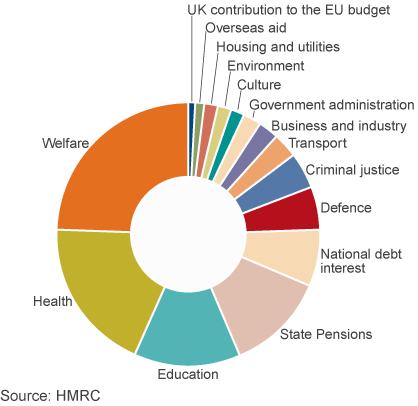 How much does the UK spend on welfare? This is a highly charged political question, with some arguing that benefit claimants are putting great demands on ‘hard-working tax payers’. According to information being sent by the government to all 24 million income tax payers in the UK, the figure of £168bn being spent on welfare is around 24.5% of public spending. But what is included in the total? Before you read on, try writing down the categories of government expenditure included under the heading ‘welfare’.
How much does the UK spend on welfare? This is a highly charged political question, with some arguing that benefit claimants are putting great demands on ‘hard-working tax payers’. According to information being sent by the government to all 24 million income tax payers in the UK, the figure of £168bn being spent on welfare is around 24.5% of public spending. But what is included in the total? Before you read on, try writing down the categories of government expenditure included under the heading ‘welfare’.
The heading does not include spending on certain parts of the ‘welfare state’, such as health and education. These are services, the production of which contributes to GDP. The category ‘welfare’ does not include expenditure on produced services, but rather transfer payments. The way the government is using the term, it does not include state pensions either, which account for 11.6% of public expenditure. So does the 24.5% largely consist of payments to the unemployed? The answer is no.
The category ‘welfare’ as used by the government includes the following elements. The percentages are of total managed expenditure (i.e. government spending).
| • | Public service pensions, paid to retired public-sector employees, such as teachers, police officers, doctors and nurses | (2.6%) |
| • | Other support for the elderly, including pension credit, winter fuel allowance, bus passes, etc. | (1.5%) |
| • | Sickness and disability benefits, including long-term care for the elderly, sick and disabled | (6.6%) |
| • | Support for families and children, such as child benefit and child tax credits | (3.4%) |
| • | Social exclusion, including income support and housing benefit | (7.8%) |
| • | Unemployment benefits, including Job Seekers Allowance | (0.7%) |
| • | Other | (1.9%) |
Lumping all these together under a single heading ‘welfare’ can be highly misleading, as many people have strongly held preconceptions about who gets welfare. In fact the term is used pejoratively by many who resent their taxes being given to those who do not work.
 But, as you can see from the figures, only a small proportion goes to the unemployed, the majority of whom (around 65%) are unemployed for less than a year as they move between jobs (see). The bulk of benefits goes to children, the retired and the working poor.
But, as you can see from the figures, only a small proportion goes to the unemployed, the majority of whom (around 65%) are unemployed for less than a year as they move between jobs (see). The bulk of benefits goes to children, the retired and the working poor.
Another preconception is that much of welfare spending goes to fraudulent claimants. But, as the article by Professor Hills states:
Just 0.7% of all benefits was over-paid as the result of fraud, less than the amount underpaid as a result of official error. For the main benefit for unemployed people, Jobseeker’s Allowance, estimated fraud was 2.9%, or an annual total of £150million.
It is also important to consider people’s life cycle. The same people receive benefits (via their parents or guardians) as children, pay taxes when they work and receive benefits when they retire or fall sick. Thus you might be a net contributor to public finances at one time and a net beneficiary at another. For example, the majority of pensioners were net contributors when they were younger and are now mainly net beneficiaries. Many unemployed people who rely on benefits now were net contributors when they had a job.
The message is that you should be careful when interpreting statistics, even if these statistics are factually accurate. How figures are grouped together and the labels put on them can give a totally misleading impression. And politicians are always keen to ‘spin’ statistics to their advantage – whether in government or opposition.
Webcast
 Annual Tax Summary: TUC and MPs on spending information BBC Daily Politics, Jo Coburn (3/11/14)
Annual Tax Summary: TUC and MPs on spending information BBC Daily Politics, Jo Coburn (3/11/14)
Articles
Osborne’s tax summary dismissed as propaganda by the TU BBC News (3/11/14)
The truth about welfare spending: Facts or propaganda? BBC News, Brian Milligan (4/11/14)
Its Cost Is Just One of the Myths Around ‘Welfare’ Huffington Post, John Hills (12/11/14)
Welfare spending summary criticised Express & Star (4/11/14)
Data and Reports
Public Expenditure: Statistical Analyses (PESA) 2014 HM Treasury (see Table 5.2)
DWP annual report and accounts 2013 to 2014 Department of Work and Pensions (see Table 2)
Welfare trends report – October 2014 Office for Budget Responsibility
What is welfare spending? Institute for Fiscal Studies (4/11/14)
Questions
- What benefits do you receive? How would you expect this to change over your lifetime?
- What are the arguments for (a) reducing and (b) increasing welfare payments. In each case, under which categories of welfare would you decrease or increase the level of benefits?
- Referring to Table 5.2 in the PESA data below (the table used for the government’s calculations), which of the categories would be classified as expenditure on goods and services and which as transfer payments?
- Assess the arguments of the IFS for the reclassification of the categories of ‘welfare’ payments.
- Referring to the pie chart above, also in the BBC video and articles and Table 5.2 in the PESA data, assess the arguments about the size of the UK’s contributions to the EU budget.